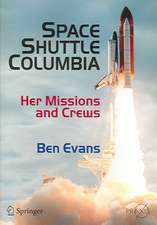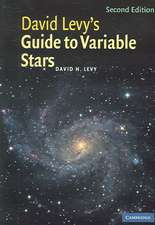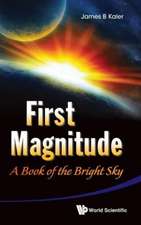Centauri Dreams: Imagining and Planning Interstellar Exploration
Autor Paul Gilsteren Limba Engleză Hardback – 8 oct 2004
| Toate formatele și edițiile | Preț | Express |
|---|---|---|
| Paperback (1) | 279.96 lei 3-5 săpt. | |
| Springer – 12 dec 2011 | 279.96 lei 3-5 săpt. | |
| Hardback (1) | 288.11 lei 3-5 săpt. | |
| Springer – 8 oct 2004 | 288.11 lei 3-5 săpt. |
Preț: 288.11 lei
Nou
Puncte Express: 432
Preț estimativ în valută:
55.13€ • 57.56$ • 45.63£
55.13€ • 57.56$ • 45.63£
Carte disponibilă
Livrare economică 14-28 martie
Preluare comenzi: 021 569.72.76
Specificații
ISBN-13: 9780387004365
ISBN-10: 038700436X
Pagini: 302
Ilustrații: XV, 302 p.
Dimensiuni: 155 x 235 x 28 mm
Greutate: 0.62 kg
Ediția:2004
Editura: Springer
Colecția Copernicus
Locul publicării:New York, NY, United States
ISBN-10: 038700436X
Pagini: 302
Ilustrații: XV, 302 p.
Dimensiuni: 155 x 235 x 28 mm
Greutate: 0.62 kg
Ediția:2004
Editura: Springer
Colecția Copernicus
Locul publicării:New York, NY, United States
Public țintă
Professional/practitionerDescriere
I wrote this book because I wanted to learn more about interstel lar flight. Not the Star Trek notion of tearing around the Galaxy in a huge spaceship-that was obviously beyond existing tech nology-but a more realistic mission. In 1989 I had videotaped Voyager 2's encounter with Neptune and watched the drama of robotic exploration over and over again. I started to wonder whether we could do something similar with Alpha Centauri, the nearest star to the Sun. Everyone seemed to agree that manned flight to the stars was out of the question, if not permanently then for the indefinitely foreseeable future. But surely we could do something with robotics. And if we could figure out a theoretical way to do it, how far were we from the actual technology that would make it happen? In other words, what was the state of our interstellar technology today, those concepts and systems that might translate into a Voyager to the stars? Finding answers meant talking to people inside and outside of NASA. I was surprised to learn that there is a large literature of interstellar flight. Nobody knows for sure how to propel a space craft fast enough to make the interstellar crossing within a time scale that would fit the conventional idea of a mission, but there are candidate systems that are under active investigation. Some of this effort begins with small systems that we'll use near the Earth and later hope to extend to deep space missions.
Cuprins
Preface; Introduction; 1 The Target; 2 The First Steps; 3 Communications over Light-Years; 4 Interplanetary Networking; 5 Imaging; 6 Propulsion Systems; 7 The Solar Sail; 8 Materials Technology; 9 Robotics; 10 Why We Must Go; Bibliography; Index.
Recenzii
From the reviews:
"Science and SF writer Gilster’s latest isn’t only an enlightening tour of propulsion and communication systems and the materials that might take us (in unmanned or even manned probes) to Centauri triple-star system 4.3 light years away (nearby in interstellar terms). The book is also a plea to remember that the urge to explore the unknown is what makes us human and that the future may not be as far away as we think. What separates this work from many scientific explorations of topics typically relegated to science fiction is that none of the methods described require breakthroughs in physics: we need no faster-than-light travel, no warp drive, no hyperspace or wormholes. All today’s scientists need is the time, funding, and license to turn their thought experiments into engineering problems. Like a master kite flyer, Gilster slowly lets out the line and allows the magnificent dreams of interstellar flight to soar – describing the relevant technologies we already possess – then he reels readers back in by pointing out the lack of funding and distance these theories still need to go before becoming reality. The technologies include sails that capture light instead of wind; a combination of fusion and antimatter reactions; and artificially intelligent computer systems that evolve over time. Metaphors and examples based on common experience put the science in perspective. This work is not only a clear, well-thought-out explanation of theoretical science and engineering but also food for the soul of anyone who has ever thought that space is a great adventure waiting to happen." – Publishers Weekly, Jan. 10, 2005
"Paul Gilster is fascinated by interstellar space flight – not the Star Trek kind, but the real thing. He takes the reader on a tour of plans being developed quietly at NASA and other space agencies for sending an unmanned probe to Alpha Centauri, the nearest star. Extensive notes capably steer readers into the technical literature. Call this book science-fiction-for-real." – Astronomy, March 2005
"Gilster takes readers on leaps of imagination beyond the probable, past the unlikely, skirting the unbelievable, through the land of supposed impossibility, into the future where, one way or another, humanity will be pursuing 'Centauri Dreams,' or, as the subtitle states, 'Imagining and Planning Interstellar Exploration.'" -- Milwaukee Journal Sentinel
"Centauri Dreams is a look at the state of the art as-yet hypothetical technology needed to take us to Earth’s second-closest star. … Author Gilster examines the possibilities with a sure-handed humor liberally illustrated with interviews with real-life experts and examples from the great science-fiction stories of Anderson, Sterling, and Clarke." (Sci Fi, 2005)
"Paul Gilster is fascinated by interstellar space flight – not the Star Trek kind, but the real thing. He takes the reader on a tour of plans being developed quietly at NASA and other space agencies … . Extensive notes capably steer readers into the technical literature." (Astronomy, March, 2005)
"‘Centauri Dreams’ consists of a thorough analysis of the alternative propulsion technologies … . This analysis is tastefully interspersed with numerous references to science-fiction ideas and writers, reflecting Gilster’s wide ranging knowledge of real science and his passion for science fiction literature. … This book is very well researched, and was for me an enjoyable read, one that I’m sure will be well enjoyed by science-fiction aficionados and hard-nosed realists alike!" (Gerard Mc Mahon, Astronomy & Space, April, 2006)
"Centauri Dreams provides a … thorough and up-to-date review of the various interstellar-travel concepts to be found in the literature. … By and large the author does a good job describing complicated concepts … . I can recommend Centauri Dreams to anyone seeking a non-technical summary of interstellar-travel concepts as they stand at the beginning of the 21st century." (Ian Crawford, The Observatory, Vol. 125 (1188), 2005)
"Paul Gilster explains some of the ongoing research … that may one day lead to an unmanned, possibly even robotic or manned, space probe being sent to Alpha Centauri, the nearest bright star outside of our solar system. … Centauri Dreams … contains thirty pages of notes that enhance the reading. General audiences and professionals will find this book a fascinating read about the possibilities of future interstellar travel." (Alvin K. Benson, Salem Press, September, 2005)
"The fastest manmade vehicle is now Voyager 1, heading out of the solar system. It could cross the US in less than four minutes. Even at that speed it will take 70,000 years to reach the nearest star, Alpha Centauri. … Paul Gilster’s book explores the terrain at the frontiers of hard logic and hairy thinking. Interstellar travel is now part of imagination’s landscape. … The interstellar idea, says Gilster, in this exhilarating book, is taking shape." (Tim Radford, The Guardian, March, 2005)
"Science and SF writer Gilster’s latest isn’t only an enlightening tour of propulsion and communication systems and the materials that might take us (in unmanned or even manned probes) to Centauri triple-star system 4.3 light years away (nearby in interstellar terms). The book is also a plea to remember that the urge to explore the unknown is what makes us human and that the future may not be as far away as we think. What separates this work from many scientific explorations of topics typically relegated to science fiction is that none of the methods described require breakthroughs in physics: we need no faster-than-light travel, no warp drive, no hyperspace or wormholes. All today’s scientists need is the time, funding, and license to turn their thought experiments into engineering problems. Like a master kite flyer, Gilster slowly lets out the line and allows the magnificent dreams of interstellar flight to soar – describing the relevant technologies we already possess – then he reels readers back in by pointing out the lack of funding and distance these theories still need to go before becoming reality. The technologies include sails that capture light instead of wind; a combination of fusion and antimatter reactions; and artificially intelligent computer systems that evolve over time. Metaphors and examples based on common experience put the science in perspective. This work is not only a clear, well-thought-out explanation of theoretical science and engineering but also food for the soul of anyone who has ever thought that space is a great adventure waiting to happen." – Publishers Weekly, Jan. 10, 2005
"Paul Gilster is fascinated by interstellar space flight – not the Star Trek kind, but the real thing. He takes the reader on a tour of plans being developed quietly at NASA and other space agencies for sending an unmanned probe to Alpha Centauri, the nearest star. Extensive notes capably steer readers into the technical literature. Call this book science-fiction-for-real." – Astronomy, March 2005
"Gilster takes readers on leaps of imagination beyond the probable, past the unlikely, skirting the unbelievable, through the land of supposed impossibility, into the future where, one way or another, humanity will be pursuing 'Centauri Dreams,' or, as the subtitle states, 'Imagining and Planning Interstellar Exploration.'" -- Milwaukee Journal Sentinel
"Centauri Dreams is a look at the state of the art as-yet hypothetical technology needed to take us to Earth’s second-closest star. … Author Gilster examines the possibilities with a sure-handed humor liberally illustrated with interviews with real-life experts and examples from the great science-fiction stories of Anderson, Sterling, and Clarke." (Sci Fi, 2005)
"Paul Gilster is fascinated by interstellar space flight – not the Star Trek kind, but the real thing. He takes the reader on a tour of plans being developed quietly at NASA and other space agencies … . Extensive notes capably steer readers into the technical literature." (Astronomy, March, 2005)
"‘Centauri Dreams’ consists of a thorough analysis of the alternative propulsion technologies … . This analysis is tastefully interspersed with numerous references to science-fiction ideas and writers, reflecting Gilster’s wide ranging knowledge of real science and his passion for science fiction literature. … This book is very well researched, and was for me an enjoyable read, one that I’m sure will be well enjoyed by science-fiction aficionados and hard-nosed realists alike!" (Gerard Mc Mahon, Astronomy & Space, April, 2006)
"Centauri Dreams provides a … thorough and up-to-date review of the various interstellar-travel concepts to be found in the literature. … By and large the author does a good job describing complicated concepts … . I can recommend Centauri Dreams to anyone seeking a non-technical summary of interstellar-travel concepts as they stand at the beginning of the 21st century." (Ian Crawford, The Observatory, Vol. 125 (1188), 2005)
"Paul Gilster explains some of the ongoing research … that may one day lead to an unmanned, possibly even robotic or manned, space probe being sent to Alpha Centauri, the nearest bright star outside of our solar system. … Centauri Dreams … contains thirty pages of notes that enhance the reading. General audiences and professionals will find this book a fascinating read about the possibilities of future interstellar travel." (Alvin K. Benson, Salem Press, September, 2005)
"The fastest manmade vehicle is now Voyager 1, heading out of the solar system. It could cross the US in less than four minutes. Even at that speed it will take 70,000 years to reach the nearest star, Alpha Centauri. … Paul Gilster’s book explores the terrain at the frontiers of hard logic and hairy thinking. Interstellar travel is now part of imagination’s landscape. … The interstellar idea, says Gilster, in this exhilarating book, is taking shape." (Tim Radford, The Guardian, March, 2005)















